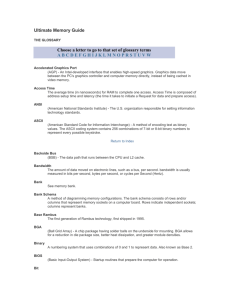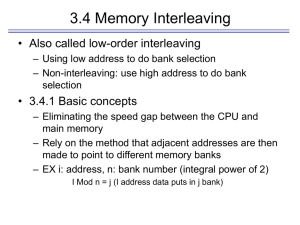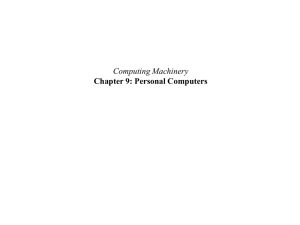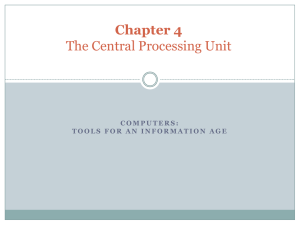Lexikon - ELECTRONIC COMPANY GmbH & Co. KG
advertisement
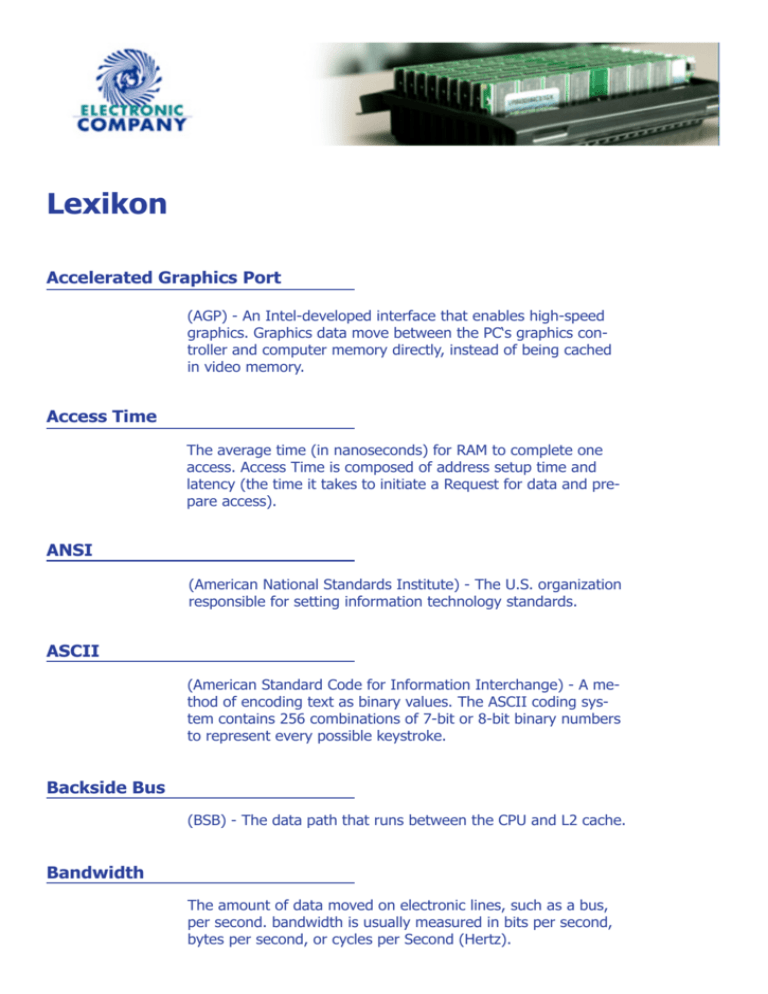
Lexikon Accelerated Graphics Port (AGP) - An Intel-developed interface that enables high-speed graphics. Graphics data move between the PC‘s graphics controller and computer memory directly, instead of being cached in video memory. Access Time The average time (in nanoseconds) for RAM to complete one access. Access Time is composed of address setup time and latency (the time it takes to initiate a Request for data and prepare access). ANSI (American National Standards Institute) - The U.S. organization responsible for setting information technology standards. ASCII (American Standard Code for Information Interchange) - A method of encoding text as binary values. The ASCII coding system contains 256 combinations of 7-bit or 8-bit binary numbers to represent every possible keystroke. Backside Bus (BSB) - The data path that runs between the CPU and L2 cache. Bandwidth The amount of data moved on electronic lines, such as a bus, per second. bandwidth is usually measured in bits per second, bytes per second, or cycles per Second (Hertz). Bank See memory bank. Bank Schema A method of diagramming memory configurations. The bank schema consists of rows and/or columns that represent memory sockets on a computer board. Rows indicate independent sockets; columns represent banks. Base Rambus The first generation of Rambus technology, first shipped in 1995. BGA (Ball Grid Array) - A chip package having solder balls on the underside for mounting. BGA allows for a reduction in die package size, better heat dissipation, and greater module densities. Binary A numbering system that uses combinations of 0 and 1 to represent data. Also known as Base 2. BIOS (Basic Input-Output System) - Startup routines that prepare the computer for operation. Bit The smallest unit of information a computer processes. A bit is 1 or 0. Buffer A holding area for data shared by devices that operate at different speeds or have different priorities. A buffer allows a device to operate without the delays that other devices impose. Buffered Memory A memory module that contains buffers. Buffers re-drive the signals through the memory chips and allow the module to include more memory chips. Buffered and unbuffered memory cannot be mixed. The design of the computer memory controller dictates whether memory must be buffered or unbuffered. Burst EDO RAM (BEDO) - EDO memory that can process four memory addresses in one burst. Bus speeds range from 50MHz to 66MHz (compared to 33MHz for EDO and 25MHz for Fast Page Mode). Burst Mode High-speed transmission of a block of data (a series of consecutive addresses) when the processor requests a single address. Bus A data path in a computer, consisting of various parallel wires to which the CPU, memory, and all input/output devices are connected. Bus Cycle A single transaction between main memory and the CPU. Byte Eight bits of information. The byte is the fundamental unit of computer processing; almost all specifications and measures of computer performance are in bytes or multiples thereof. See kilobytes and megabytes. Cache Memory A small amount (normally less than 1MB) of high-speed memory residing on or close to the CPU. Cache memory supplies the processor with the most frequently requested data and instructions. Level 1 cache (primary cache) is the cache closest to the processor. Level 2 cache (secondary cache) is the cache second closest to the processor and is usually on the motherboard. CAS (Column Address Strobe) - A memory chip signal that latches the column address of a particular location in a row-column matrix. CAS Latency The ratio between column access time and clock cycle time. CAS Latency 2 (CL2) offers a slight performance increase over CAS Latency 3 (CL3). ccNUMA (Cache-Coherent, Non-uniform Memory Access) - A flexible architecture that uses modular, low-cost components and offers multidimensional scaling potential to high-end servers. Chipset Microchips that support the CPU. The chipset usually contains several controllers that govern how information travels between the processor and other components. Chip-Scale Package (CSP) - Thin chip packaging whereby electrical connections are typically through a ball grid array. Chip-scale packaging is used in RDRAM and flash memory. CompactFlash A small, lightweight form factor for removable storage cards. CompactFlash cards are durable, operate at low voltages, and retain data when power is off. Uses include digital cameras, cell phones, printers, handheld computers, pagers, and audio recorders. Composite An Apple Computer, Inc. term for a memory module that used an older technology and contained more but lower-density chips. Concurrent Rambus The second generation of Rambus technology. Concurrent Rambus has been used in graphics-based computers, digital TVs, and video game applications (such as Nintendo 64 since 1997). Continuity RIMM (C-RIMM) - A Direct Rambus memory module that does not contain memory chips. C-RIMM provides a continuous channel for the signal. In a Direct Rambus system, open connectors must be populated with C-RIMMs. CPU (Central Processing Unit) - The computer chip that has primary responsibility for interpreting commands and running programs. The CPU is also known as the processor or microprocessor. Credit Card Memory A type of memory typically in laptop and notebook computers. Credit card memory is the size of a credit card. DDR SDRAM (Double Data Rate Synchronous Dynamic Random-Access Memory) - The latest generation of SDRAM technology. Data is read on both the rising and the falling edge of the computer clock, thereby delivering twice the bandwidth of standard SDRAM. With DDR SDRAM, memory speed doubles without increasing the clock frequency. DIMM (Dual In-line Memory Module) - A printed circuit board with gold contacts and memory devices. A DIMM is similar to a SIMM, but with this primary difference: unlike the metal leads on either side of a SIMM, which are „tied together“ electrically, the leads on either side of a DIMM are electrically independent. Direct Rambus Rambus technology‘s third generation, which offers a completely new DRAM architecture for high-performance PCs. Data transfers at speeds up to 800MHz over a narrow 16-bit channel, compared to current SDRAM, which operates at 100MHz on a wide 64-bit bus. DIP (Dual In-line Package) - A DRAM component packaging. DIPs can be installed in sockets or permanently soldered into holes on the printed circuit board. The DIP package was extremely popular when memory was installed directly on the motherboard. DRAM (Dynamic Random-Access Memory) - The most common form of RAM. DRAM can hold data for only a short time. To retain data, DRAM must be refreshed periodically. If the cell is not refreshed, the data disappear. Dual-Banked A memory module having two banks. Dual Channel Based on the dual channel system board designs, memory modules are installed on two separate channels, each with it’s own access route to the memory controller. The dual memory channel design doubles the peak bandwidth of single memory channels. Best results occur when a matched-pair memory kit is used ensuring that the modules are identical. Dual Independent Bus (DIB) - An Intel-developed bus architecture that offers greater bandwidth by having two separate buses (frontside and backside) access the processor. Pentium II computers have DIBs. ECC (Error Correction Code) - A method of checking the integrity of data in DRAM. ECC provides more elaborate error detection than parity; ECC can detect multiple-bit errors and can locate and correct single-bit errors. EDO (Extended Data-Out) - A DRAM technology that shortens the read cycle between memory and CPU. On computers that support it, EDO memory allows a CPU to access memory 10 to 20 percent faster than comparable fast-page mode memory. EDRAM (Enhanced DRAM) - Enhanced Memory Systems, Inc. DRAM that contains a small amount of SRAM. EEPROM (Electrically Erasable Programmable Read-Only Memory) - A memory chip that retains data content after power has been removed. EEPROM can be erased and reprogrammed within the computer or externally. EISA (Extended ISA) - A bus architecture that extended the 16-bit ISA bus to 32 bits. EISA operates at 8MHz and has a peak data transfer rate of 33MB per second. EISA was introduced in 1988 as an open alternative to IBM‘s proprietary Micro Channel bus. EOS (ECC on SIMM) - An IBM data-integrity-checking technology that features ECC data-integrity-checking on a SIMM. EPROM (Erasable Programmable Read-Only Memory) - A programmable and reusable chip that retains content until erasure under ultraviolet light. Special equipment erases and reprograms EPROMs. ESDRAM (Enhanced Synchronous DRAM) - A type of SDRAM developed by Enhanced Memory Systems, Inc. ESDRAM replaces expensive SRAM in embedded systems and offers comparable speed with less power consumption and lower cost. Even Parity A type of data integrity checking whereby the parity bit checks for an even number of 1s. Fast-Cycle RAM (FCRAM) - FCRAM is a memory technology currently being developed by Toshiba and Fujitsu. FCRAM is not intended for PC main memory but will be used in specialty applications such as high-end servers, printers, and telecommunications switching systems. Fast-Page Mode An early form of DRAM, fast-page mode‘s advantage over previous page mode memory technologies was faster access to data in the same row. Flash Memory A solid-state, nonvolatile, rewritable memory that functions like a combination of RAM and hard disk. Flash memory is durable, operates at low voltages, and retains data when power is off. Flash memory cards are used in digital cameras, cell phones, printers, handheld computers, pagers, and audio recorders. Form Factor The size, configuration, and other specifications used to describe hardware. Examples of memory form factors are: SIMM, DIMM, RIMM, 30-pin, 72-pin, and 168-pin. Frontside Bus (FSB) - The data path that runs between the CPU and main memory (RAM). Gigabit Approximately 1 billion bits, or exactly 1 bit x 1,0243 (1,073,741,824) bits. Gigabyte Approximately 1 billion bytes, or exactly 1 byte x 1,0243 (1,073,741,824) bytes. Heat Spreader A sheath, usually aluminum, that covers an electronic device and dissipates heat. Heat Sink A component, typically zinc alloy, that dissipates heat. CPUs require heat sinks. IC (Integrated Circuit) - An electronic circuit on a semiconductor chip. The circuit includes components and connectors. A semiconductor chip is usually molded in a plastic or ceramic case and has external connector pins. Interleaving Techniques for increasing memory speed. For example, with separate memory banks for odd and even addresses, the next byte of memory can be accessed while the current byte refreshes. JEDEC (Joint Electron Device Engineering Council) - An Electronic Industries Alliance (EIA) body that sets semiconductor engineering standards. Kilobit Approximately one thousand bits, or exactly 1 bit x 210 (1,024) bits. Kilobyte Approximately one thousand bytes, or exactly 1 byte x 210 (1,024) bytes. Level 1 Cache (L1) - Also known as primary cache, L1 Cache is a small amount of high-speed memory that resides on or very close to the processor. L1 Cache supplies the processor with the most frequently requested data and instructions. Level 2 Cache (L2) - Also known as secondary cache, L2 Cache is a small amount of high-speed memory close to the CPU and usually on the motherboard. L2 Cache supplies the processor with the most frequently requested data and instructions. Depending on the motherboard, Level 2 cache may be upgraded. Logic Board See Motherboard. Megabit Approximately one million bits, or exactly 1 bit x 1,0242 (1,048,576) bits. Megabyte Approximately one million bytes, or exactly 1 byte x 1,0242 (1,048,576) bytes. Memory A computer‘s random-access memory. Memory temporarily holds data and instructions for the CPU. See RAM. Memory Bank A logical unit of memory in a computer, the size of which the CPU determines. For example, a 32-bit CPU requires memory banks that provide 32 bits of information at a time. A bank can consist of one or more memory modules. Memory Bus The bus that runs from the CPU to the memory expansion slots. Memory Controller Hub (MCH) - The interface between the processor, Accelerated Graphics Port, and RDRAM on motherboards that use Intel‘s 820 or 840 chipsets. Memory Translator Hub (MTH) - The interface that allows SDRAM memory to be supported on a Direct Rambus Channel for motherboards using Intel‘s 820 chipset. Micro BGA (µBGA) - Tessera, Inc. BGA chip packaging technique allows for a reduction in die package size, improved heat dissipation, and greater module densities. MicroDIMM (Micro Dual In-Line Memory Module) - Smaller than an SODIMM, MicroDIMMS are primarily used in sub-notebook computers. MicroDIMMs are available in 144-pin SDRAM and 172-pin DDR. Motherboard Also known as the logic board, main board, or computer board, the motherboard is the computer‘s main board and in most cases holds all CPU, memory, and I/O functions or has expansion slots for them. Nanosecond (ns) - One billionth of a second. Memory data access times are in nanoseconds. For example, memory access times for typical 30- and 72-pin SIMM modules range from 60 to 100 nanoseconds. Nibble Half of an 8-bit byte, or 4 bits. Non-Composite An Apple Computer, Inc. term for a memory module that used a new technology and contained fewer but higher-density chips. Non-composite modules were more reliable and more expensive than composite modules. Odd Parity Data integrity checking in which the parity bit checks for an odd number of 1s. Parity Data integrity checking that adds a single bit to each byte of data. The parity bit is used to detect errors in the other 8 bits. PCB (Printed Circuit Board) - Generally flat, multi-layer boards made of fiberglass with electrical traces. The surface and sublayers use copper traces to provide electrical connections for chips and other components. Examples of PCBs include: mother-boards, SIMMs, and credit card memory. PC Card (PCMCIA: Personal Computer Memory Card International Association) - A standard that allows interchangeability of various computing components on the same connector. The PCMCIA standard supports input-output devices, including memory, fax/ modem, SCSI, and networking products. PCI (Peripheral Component Interconnect) - A peripheral bus that can send 32 or 64 bits of data simultaneously. PCI offers plugand-play capability. Pipeline Burst Cache Cache that reduces wait states and accelerates memory access by using pipelining and bursting functions. Pipelining A technique in which memory loads the requested memory contents into a small cache composed of SRAM, then immediately begins fetching the next memory contents. This creates a two-stage pipeline, where data is read from or written to SRAM in one stage, and data is read from or written to memory in the other stage. Proprietary Memory Memory custom designed for a specific computer. RAM (Random-Access Memory) - A memory cell configuration that holds data for processing by a central processing unit (CPU). Random means the CPU can retrieve data from any address within RAM. See also Memory. Rambus (1) Rambus, Inc. develops and licenses high-performance memory logic and circuit design technology and provides licensees with product design, layout, and testing information. (2) Direct Rambus is a high-speed memory technology that uses a narrow 16-bit bus (Rambus channel) to transmit data at speeds up to 800MHz. See Rambus Channel. Rambus Channel The data path of Rambus systems. Because of the narrow data width (two bytes), Rambus modules transfer data at up to 800MHz. RAS A memory chip signal that latches the row address of a particular location in a row-column matrix. Refresh Refreshing maintains data stored in DRAM. The process of refreshing electrical cells on a DRAM component is similar to recharging batteries. Different DRAM components require different refresh methods. Refresh Rate The number of DRAM component rows that must be refreshed. Three common refresh rates are 2K, 4K and 8K. Registered Memory SDRAM memory that contains registers directly on the module. The registers re-drive the signals through the memory chips and allow the module to be built with more memory chips. Registered and unbuffered memory cannot be mixed. The design of the computer memory controller dictates which type of memory the computer requires. RIMM™ The trademarked name for a Direct Rambus memory module. A RIMM™ conforms to the DIMM form factor and transfers data 16 bits at a time. RIMM Connector A Direct Rambus memory socket. SDRAM (Synchronous DRAM) - A DRAM technology that uses a clock to synchronize signal input and output on a memory chip. The clock is coordinated with the CPU clock so the timing of the memory chips and the timing of the CPU are in synch. Synchronous DRAM saves time in executing commands and transmitting data, thereby increasing the overall performance of the computer. SDRAM allows the CPU to access memory approximately 25 percent faster than EDO memory. Self-Refresh A memory technology that enables DRAM to refresh on its own and independent of the CPU or external refresh circuitry. Self-Refresh technology is built into the DRAM chip itself and reduces power consumption dramatically. Notebook and laptop computers use this technology. Serial Presence Detect An EEPROM chip that contains information about size and speed, as well as other specifications and manufacturer information of a memory module. SGRAM (Synchronous Graphics Random-Access Memory) - Video memory that includes graphics-specific read/write features. SGRAM allows data to be retrieved and modified in blocks instead of individually. Blocking reduces the number of reads and writes the memory must perform and increases the performance of the graphics controller. SIMM (Single In-line Memory Module) - A printed circuit board having memory devices and gold or tin/lead contacts. A SIMM plugs into a computer memory expansion socket. SIMMs offer two main advantages: ease of installation and minimal consumption of board surface. A vertically mounted SIMM requires only a fraction of the space required by a horizontally mounted DRAM. A SIMM may have as few as 30 or as many as 200 pins. On a SIMM, the metal leads on either side of the board are electrically tied together. SIMM Socket A motherboard component that holds a single SIMM. Single-Banked A module that has only one bank or row. SLDRAM (Synclink) - Although obsolete today, SLDRAM was a main memory technology developed by a consortium of twelve DRAM manufacturers as an alternative to Direct Rambus technology. SMART CARD An electronic device, similar in size to a credit card, that can store data and programs while enhancing security. Applications include identification, mass transit, and banking. SO DIMM (Small-Outline Dual In-line Memory Module) - An enhanced version of a standard DIMM. A 72-pin small-outline DIMM is about half the length of a 72-pin SIMM. SO-RIMM™ The trademarked name for a Direct Rambus memory module in notebook computers. SO-RIMM™s provide memory bandwidth comparable to desktop memory configurations. SOJ (Small-Outline J-lead) - A common form of surface-mounted DRAM packaging. An SOJ is a rectangular package with Jshaped leads on the two long sides. Static RAM (SRAM) - A memory chip that requires power to retain content. SRAM is faster than DRAM but more expensive and bulky. A typical use for SRAM is cache memory. Storage A data-holding device, such as a hard disk or CD-ROM. sTSOP (Thin Small-Outline Package) A DRAM package that uses gull-wing leads on both sides. TSOP DRAM mounts directly on the surface of the printed circuit board. The TSOP package is one-third the thickness of an SOJ. TSOP components commonly occur in small-outline DIMMs and credit card memory. Swapping Using part of the hard drive as memory when RAM is full. See Virtual Memory. System Board See Motherboard. Transmission Line Technology A technology that supports the backside bus in Direct Rambus systems.Information is quickly pipelined in simultaneous packets. The memory controller reassembles the packets for frontside bus transfer and communication to the processor. TSOP (Thin Small-Outline Package) - A DRAM package that uses gull-wing leads on both sides. TSOP DRAM mounts directly on the surface of the printed circuit board. The TSOP package is one-third the thickness of an SOJ. TSOP components commonly occur in small-outline DIMMs and credit card memory. Unbuffered Memory Memory that does not contain buffers or registers located on the module. Instead, these devices are located on the motherboard. VESA Local Bus (VL-Bus) - A 32-bit local bus that runs between the CPU and peripheral devices at speeds up to 40MHz. Virtual Channel Memory (VCM) - VCM is a memory architecture developed by NEC. VCM allows different blocks of memory-each with its own buffer-to interface separately with the controller. This way, system tasks can be assigned their own virtual channels. Information related to one function does not share buffer space with other tasks running simultaneously, thereby making overall operations much more efficient. Virtual Memory Simulated memory. When RAM is full, the computer swaps data to the hard disk and back as needed. See Swapping. VRAM (Video Random-Access Memory) - Dual-ported (two separate data ports) memory typically on a video or graphics card. One port is dedicated to the CRT and refreshes and updates the image. The second port is for the CPU or graphics controller and changes the image data in memory. Wait State An inactive period for the processor. Wait states result from the different clock speeds of the processor and memory, the latter being typically slower. Window Random Access Memory (WRAM) - Samsung Electronics‘ dual-ported (two separate data ports) memory typically on a video or graphics card. WRAM has a 25% higher bandwidth than VRAM but costs less.

